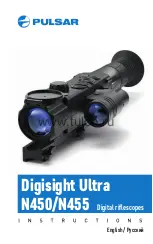
0
You. should. experiment. with. the. brightness. setting.
at. night,. which. depends. on. how. bright. your. target. is.
and. how. lit-up. the. sky. itself. is. from. moonlight. and/or.
light.pollution..Note.that.battery.life.of.the.LED.source.
depends.on.how.much.and.how.brightly.you.use.it.–.
and.also.remembering.to.turn.it.off.when.you’re.finished.
observing!. The. LED. source. is. powered. by. a. lithium.
wafer-type.battery,.#CR.2032,.and.if/when.necessary,.
replacements.can.be.found.at.Radio.Shack,.Wal-Mart,.
and.also.in.most.drugstores.and.supermarkets.
Using the Dew/Light Shield
It’s.recommended.that.you.keep.the.dew/light.shield.in.
place.on.the.telescope.at.all.times.(except.for.shipping)..
As. its. name. implies,. its. purpose. is. twofold.. One. is. to.
help.prevent.condensation.from.forming.on.the.optical.
window. as. it’s. exposed. to. the. night. air. (especially.
important.on.humid.or.very.cold.nights)..The.other.is.to.
keep.stray.light.from.entering.the.telescope.(especially.
important. near. streetlights. or. a. neighbor’s. house. and.
porch.lights,.and.also.bright.surrounding.light.from.the.
sky.when.viewing.in.the.daytime).
Using the Rubber Eyeguard
Somewhat.related.in.function.to.the.dew/light.shield.is.
the. rubber. eyeguard.. It. helps. to. keep. stray. light. from.
entering.the.eyepiece.and.also.to.position.the.eye.at.the.
optimum.distance.from.the.eyepiece.to.see.the.entire.
field.of.view..It.also.cushions.eyeglasses.(for.those.who.
must.wear.them).from.hitting.the.lens.of.the.eyepiece..
However,.stretching.the.narrow.part.of.the.rubber.to.fit.
properly.and.at.the.right.position.over.the.eyepiece.is.a.
bit.tricky..Another.problem.is.that.eyeguards.often.cause.
the.eyepiece.itself.to.fog.up.from.moisture.held.within.
them.from.air.around.the.observer’s.eye.as.it’s.pressed.
against.them..But.you.can.experiment.with.the.eyeguard.
to.see.how.it.works.for.you!.(Some.stargazers.prefer.to.
use.a.black.“photographer’s.cloth”.–.available.in.camera.
stores.–.draped.over.their.head.and.the.eyepiece.area.
to.totally.block.out.all.unwanted.light.)
Sky and Viewing Conditions
“Good.seeing”.for.stargazing.depends.on.many.factors.
but. it’s. specifically. concerned. with. the. state. of. the.
atmosphere. through. which. the. telescope. must. look..
There.are.two.different.conditions.at.play.here:.one.is.
the.“seeing”.or.how.
steady
.the.air.is,.and.the.other.is.
“transparency”.or.how.
clear
.the.air.is..The.atmosphere.
is.constantly.in.motion.at.different.altitudes,.but.some.
nights. more. so. than. others.. When. you. get. a. crystal-
clear.sky,.there’s.lots.of.upper.atmospheric.movement.
and.the.stars.typically.twinkle.continuously..These.are.
poor.nights.if.looking.for.detail.on.the.Moon.and.planets.
or.trying.to.split.close.double.stars..But.they.are.ideal.for.
observing. faint. objects. like. star. clusters,. nebulae,. the.
Milky.Way.and.galaxies..Conversely,.hazy,.muggy.nights.
indicate.that.the.atmosphere.is.very.tranquil..Images.are.
typically.sharp.and.steady.–.ideal.for.close-up.viewing.of.
the.Moon,.planets.and.stars.
Rare,. however,. are. nights. when. you. can. use. powers.
over. 300X. regardless. of. the. size. or. quality. of. your.
telescope.. Fortunately,. atmospheric. disturbances. are.
seldom.a.problem.at.the.low.magnifications.employed.
by. the.Astroscan.. Sky. targets. are. best. viewed. on. or.
near.the.“celestial.meridian.”.This.is.an.imaginary.line.
passing. north-south. through. the. overhead. point. or.
“zenith.”. Objects. rise. in. the. east,. cross. the. meridian,.
and.then.set.in.the.west.due.to.the.rotation.of.the.Earth..
When.on.the.meridian,.they.are.at.their.highest.in.the.
sky.and.also.at.their.sharpest..
Observing. over. a. hot. driveway. or. roof,. or. through.
an. open. window,. is. to. be. avoided. due. to. rising. heat.
currents. distorting. the. images. seen.. Open. window.
viewing. is. practical. only. when. the. indoor. and. outdoor.
air.are.nearly.the.same.temperature..Even.so,.a.power.
of. 50X. is. tops. for. this. kind. of. viewing.. Additionally,.
looking.through.window.glass.is.generally.discouraged.
because.the.imperfections.in.the.glass.produce.obvious.
optical. distortions. under.magnification.. However,.used..
at.its.lowest.magnification.of.16X,.the.Astroscan.does.
make.it.possible.to.study.nature.this.way.despite.some.
minor.image.distortion.–.something.especially.welcome.
on.cold,.wintry.days!
The dew/light shield.



































